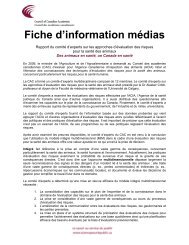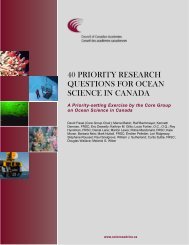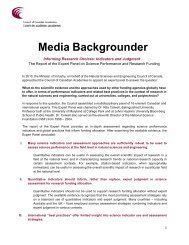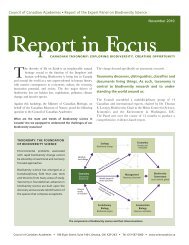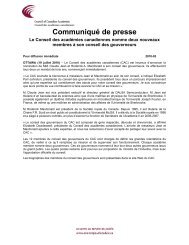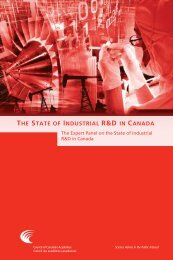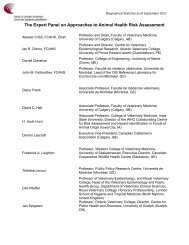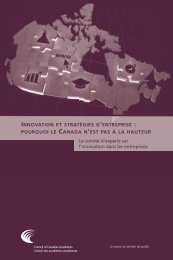Influenza Tr<strong>an</strong>smission <strong>an</strong>d <strong>the</strong> Role <strong>of</strong> PPRE: An Assessment <strong>of</strong> <strong>the</strong> Evidence 19Table 1Behaviour <strong>of</strong> Droplets in Still Air (adapted from Ev<strong>an</strong>s, 2000)Diameter Settling velocity (cm/sec) Time to fall(µm) (Stoke’s Law) 3 meters100.0 25.0 10 sec30.0 2.7 70 sec10.0 0.31 17 min3.0 0.028 3 hours0.3 0.00042 8.4 days0.03 0.000022 159 daysEffect <strong>of</strong> EvaporationParticles, once ejected from <strong>the</strong> respiratory tract <strong>of</strong> <strong>an</strong> infected person, are subjected to<strong>the</strong> effects <strong>of</strong> evaporation. The rate <strong>of</strong> evaporation <strong>of</strong> <strong>the</strong> water in <strong>the</strong> particles islargely determined by <strong>the</strong> amount <strong>of</strong> water present in <strong>the</strong> air (relative humidity), <strong>the</strong>prevailing temperature, <strong>an</strong>d <strong>the</strong> surface area <strong>of</strong> <strong>the</strong> particles (Lighthart, 1991;Duguid, 1946; Lidwell, 1967; Yassi, 2004). For a unit volume <strong>of</strong> water in air, <strong>the</strong>ratio <strong>of</strong> surface area to volume doubles as <strong>the</strong> droplet diametre decreases by one-half.For this reason, <strong>the</strong> evaporation rate is faster for smaller particles. The evaporationrate also increases with rising air temperature <strong>an</strong>d/or falling relative humidity.In a study that involved spraying a microbe-laden aerosol (i.e., mist) into <strong>the</strong> air<strong>an</strong>d measuring <strong>the</strong> course <strong>of</strong> droplet size <strong>an</strong>d downwind behaviour, Lighthart et al.(1991) showed that, at 49 per cent relative humidity <strong>an</strong>d 21˚C , droplets in <strong>the</strong>80 µm diametre r<strong>an</strong>ge evaporated before <strong>the</strong> droplets reached <strong>the</strong> ground; <strong>an</strong>d <strong>the</strong>water in <strong>the</strong> particles with initial diametres less th<strong>an</strong> 35 µm evaporated in less th<strong>an</strong>one second. Lidwell re-evaluated Duguid’s 1946 data <strong>an</strong>d found that <strong>the</strong> watercontained in <strong>the</strong> 5 to 50 µm particle size r<strong>an</strong>ge quickly evaporated, reducing <strong>the</strong>particle sizes to <strong>the</strong> 1 to 10 µm r<strong>an</strong>ge (Duguid, 1946; Lidwell, 1967). Therefore,because <strong>of</strong> evaporation, expelled particles do not remain <strong>the</strong> same size. M<strong>an</strong>y <strong>of</strong> <strong>the</strong>larger ones very quickly end up as smaller particles as evaporation proceeds.Effect <strong>of</strong> HumidityThe relative humidity affects not only how quickly evaporation occurs, but to whatextent it will occur. The rate <strong>of</strong> evaporation decreases as relative humidity increases<strong>an</strong>d is slowed by <strong>the</strong> presence <strong>of</strong> salts, proteins <strong>an</strong>d o<strong>the</strong>r non-volatile componentspresent in <strong>an</strong> ejected respiratory tract particle. As described by Yassi et al.(2004),while a droplet <strong>of</strong> pure water will evaporate fully if relative humidity is less th<strong>an</strong> 100per cent, a droplet that contains soluble material, such as sodium chloride, will reach
20 Influenza Tr<strong>an</strong>smission <strong>an</strong>d <strong>the</strong> Role <strong>of</strong> PPRE: An Assessment <strong>of</strong> <strong>the</strong> Evidence<strong>an</strong> equilibrium state which depends jointly on <strong>the</strong> concentration <strong>of</strong> <strong>the</strong> sodiumchloride contained in <strong>the</strong> droplet <strong>an</strong>d <strong>the</strong> relative humidity <strong>of</strong> <strong>the</strong> ambient air.Since respiratory secretions contain m<strong>an</strong>y different compounds as solutes orsuspended material, <strong>the</strong> water in particles that contain microorg<strong>an</strong>isms, will notalways completely evaporate in ambient air. However, in <strong>an</strong> HVAC-equipped building, 11located in a temperate climate, a relative humidity <strong>of</strong> 40 per cent or lower c<strong>an</strong> beexpected, particularly during winter months. Under <strong>the</strong>se conditions, <strong>the</strong> water ina particle containing soluble material will evaporate completely, leaving behind adroplet nucleus that could contain <strong>an</strong>y infectious agents that were originally present(Yassi, 2004). If <strong>the</strong>se biological agents are not damaged by <strong>the</strong> drying process <strong>the</strong>yc<strong>an</strong> potentially infect a susceptible host if inhaled.Effect <strong>of</strong> Dist<strong>an</strong>ceThe physics <strong>of</strong> breathing, coughing, talking or sneezing plays <strong>an</strong> import<strong>an</strong>t role indetermining how far <strong>an</strong>d how quickly <strong>an</strong> ejected respiratory particle c<strong>an</strong> travel.The average total volume <strong>of</strong> emitted material in a cough is approximately fourmicrolitres at <strong>the</strong> moment <strong>of</strong> exhalation. Almost all <strong>of</strong> this volume is composed <strong>of</strong>larger particles that follow ballistic trajectories <strong>an</strong>d l<strong>an</strong>d on “surfaces” withinroughly one metre <strong>of</strong> <strong>the</strong> source (Duguid, 1946; Nicas, 2005; Loudon, 1967). Theremaining volume remains in <strong>the</strong> air as <strong>an</strong> evaporating mist with <strong>the</strong> liquid particlesconverting to desiccated particles (droplet nuclei) at a rate inversely proportionalto <strong>the</strong>ir size.Figure 2Particle mist created upon sneezing. (Davidhazy, 2007)11 HVAC = heating, ventilation <strong>an</strong>d air-conditioning





